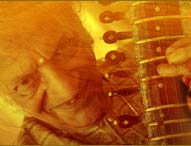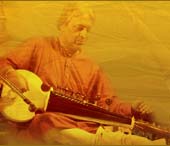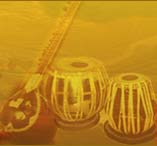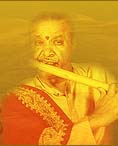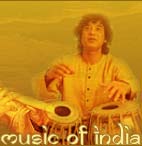Nadaswaram, also known as Nagaswaram, is considered to be one of the most ancient and unique musical instruments of Tamil Nadu. It is extremely appropriate to call this instrument a rare combination of music and divinity because of its consideration as a very auspicious instrument and is thus, found at temples and at weddings. Each part of the Nadaswaram is related to a deity. The bottom circle to Surya, the Sun God, the upper hole to Goddess Shakti, the inner holes to Lord Vishnu, the body to Lord Brahma, and the seven holes to seven mothers. It is normally accompanied by a Sur Peti, Ottu, and a tavil. There is a smaller version of the Nadaswaram which is played in folk music and is known Mukhavina. Nadaswaram is a South-Indian version of Shehnai but is substantially larger and has a simple double reed rather that the more complex quadruple reed. The instrument is usually played in pairs, and accompanied by a pair of drums called thavil. Nadaswaram is unique from other wind instruments because performers put their lips straight-forward on the double reed and it can be played using circular breathing.
History
Primarily, "Shankh" was used as an instrument to produce sound by blowing air into it. Thereafter, the horns of ox and bull were selected and holes were made into these to produce musical sounds. Later bamboos and metals started being used. Nadaswaram and other instruments like Ottu, Shehnai, Makuti etc., are the culmination of such efforts. Silapadikaram refers to an instrument called "vangiyam". The structure of this instrument is the same to that of Nadaswaram. The instrument was also called "Ezhil" because there are seven holes that are played with seven fingers.
Description Of Nadaswaram
The Nadaswaram contains three parts namely, kuzhal, thimiru, and anasu. There is a tree called as aacha and traditionally, the body of Nadaswaram is made out of it. It is a double reed instrument with a conical bore which gradually enlarges toward the lower end. It is usually made of a type of ebony. The top portion has a metal staple into which a small metallic cylinder is inserted that is due to carry the mouthpiece made of reed. The Nadaswaram has seven finger-holes. There are five additional holes drilled at the bottom which are used as controllers. It has a range of two and a half octaves like the flute. The system of fingering Nadaswaram is similar to that of the flute, but unlike the flute, where semi and quarter tones are produced by the partial opening and closing of the finger holes, in the Nadaswaram they are produced by adjusting the pressure and strength of the air-flow into the pipe. Also, due to its intense volume and strength it is basically an outdoor instrument and much more suited for open spaces than for closed indoor concert situations.
Occasions
Nadaswaram is considered as a holy device as all the parts of the instrument are related to a deity. While the bottom circle is related to Surya, the Sun God, the upper hole is dedicated to Goddess Shakti. The inner holes are for Lord Vishnu, the body for Lord Brahma, and the seven holes for the seven mothers. Thus, it is mostly used during weddings and the temples of South Indian tradition.
Famous Nadaswaram Players
Some of the greatest early exponents of the Nadaswaram include Thiruvavadudurai Rajaratnam Pillai, Dr. Thiruvengadu Subramania Pillai and Sangita Kalanidi Thiruvizhimizhalai Subrahmanya Pillai. In more recent times Namagiripettai Krishnan, Karukurichi Arunachalam, Sheik Chinna Moulana, Thiruvarur S Latchappa Pillai, Sheik Mahaboob Subhani and the Sembanarkovil Brothers (S R G Sambandam and S R G Rajanna) are well known. U.S. composers such as Lewis Spratlan and Carl Stone have expressed admiration for the Nadaswaram, and a few jazz musicians have taken up the instrument. Charlie Mariano is one of the few non-Indians able to play the instrument, having studied it while living in India. Other prominent names who have recorded with the instrument include Vinny Golia, J. D. Parran, and William Parker.
